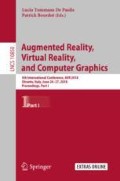Abstract
The esthetics and personality of animated agents play an important role in enhancing the experience of human-computer interactions. In the context of online learning and instruction, research shows that the personality of pedagogical agents can have a significant impact on students’ learning. The study reported in the paper focused on the expression of agents’ personality through non-verbal cues. In particular, it investigated whether certain gait parameters affect how the audience perceives the personality of a stylized animated pedagogical agent walking in a virtual classroom. While evidence exists that the way a character walks can affect the viewer’s perception of his/her personality, it is not clear yet which specific gait attributes contribute the most to identifying the personality of the character. In this study, six different parameters of gait were examined to see how slight changes in their values could help the audience perceive the agent as an extrovert. The study included 18 video stimuli and data was collected from 79 participants. Findings confirmed the effect gait can have on the perception of personality. They further suggest that stride length, beat of the walk (e.g. walking speed) beltline tilt, and upper body twist contribute the most towards this end.
Access this chapter
Tax calculation will be finalised at checkout
Purchases are for personal use only
References
Thomas, F., Johnston, O., Rawls, W.: Disney Animation: The Illusion of Life, vol. 4. Abbeville Press, New York (1981)
Kim, Y., Baylor, A.L., Shen, E.: Pedagogical agents as learning companions: the impact of agent emotion and gender. J. Comput. Assist. Learn. 23, 220–234 (2007)
Blisle, J.F., Bodur, H.O.: Avatars as information: perception of consumers based on their avatars in virtual worlds. Psychol. Mark. 27(8), 741–765 (2010)
Holzwarth, M., Janiszewski, C., Neumann, M.M.: The influence of avatars on online consumer shopping behavior. J. Mark. 70(4), 19–36 (2006)
Nass, C., Moon, Y., Fogg, B.J., Reeves, B., Dryer, C.: Can computer personalities be human personalities? In: Conference companion on Human Factors in Computing Systems, pp. 228–229. ACM (1995)
Lester, J., Converse, S., Kahler, S., Barlow, T., Stone, B., Bhogal, R.: The persona effect: affective impact of animated pedagogical agents. In: Proceedings of CHI 1997, pp. 359–366 (1997)
Holmes, J.: Designing agents to support learning by explaining. Comput. Educ. 48, 523–547 (2007)
Moreno, R., Mayer, R.: Interactive multimodal learning environments. Educ. Psychol. Rev. 19, 309–326 (2007)
Lusk, M.M., Atkinson, R.K.: Animated pedagogical agents: does their degree of embodiment impact learning from static or animated worked examples? Appl. Cogn. Psychol. 21, 747–764 (2007)
Cassell, J.: Embodied Conversational Agents. The MIT Press, Cambridge (2000)
Schroeder, N., Adesope, O.O., Barouch Gilbert, R.: How effective are pedagogical agents for learning? A meta-analytic review. J. Educ. Comput. Res. 49(1), 1–39 (2013)
Zhou, L., Mohammed, A.S., Zhang, D.: Mobile personal information management agent: supporting natural language interface and application integration. Inf. Process. Manag. 48(1), 23–31 (2012)
Kim, Y., Baylor, A.L.: Pedagogical agents as social models to influence learner attitudes. Educ. Technol. 47(01), 23–28 (2007)
Guo, Y.R., Goh, D.H.L.: Affect in embodied pedagogical agents: meta-analytic review. J. Educ. Comput. Res. 53(1), 124–149 (2015)
Erdle, S., Murray, H.G., Rushton, J.P.: Personality, classroom behavior, and student ratings of college teaching effectiveness: a path analysis. J. Educ. Psychol. 77(4), 394 (1985)
Bailenson, J.N., Yee, N., Merget, D., Schroeder, R.: The effect of behavioral realism and form realism of real-time avatar faces on verbal disclosure, nonverbal disclosure, emotion recognition, and co-presence in dyadic interaction. Presence Teleop. Virtual Environ. 15(4), 359–372 (2006)
Konstantinidis, E.I., Hitoglou-Antoniadou, M., Luneski, A., Bamidis, P.D., Nikolaidou, M.M.: Using affective avatars and rich multimedia content for education of children with autism. In: Proceedings of the 2nd International Conference on Pervasive Technologies Related to Assistive Environments. ACM (1995). Article No. 58
McCrae, R.R., John, O.P.: An introduction to the five factor model and its applications. J. Pers. 60(2), 175–215 (1992)
Jung, C.G.: Memories, Dreams. Reflections. Vintage, New York (1989)
Eysenck, H.J.: The Biological Basis of Personality. Transaction Publishers, New Brunswick (1967)
Neff, M., Wang, Y., Abbott, R., Walker, M.: Evaluating the effect of gesture and language on personality perception in conversational agents. In: Allbeck, J., Badler, N., Bickmore, T., Pelachaud, C., Safonova, A. (eds.) IVA 2010. LNCS (LNAI), vol. 6356, pp. 222–235. Springer, Heidelberg (2010). https://doi.org/10.1007/978-3-642-15892-6_24
Rushton, S., Morgan, J., Richard, M.: Teacher’s Myers-Briggs personality profiles: identifying effective teacher personality traits. Teach. Teach. Educ. 23, 432–441 (2007)
Riggio, R.E., Friedman, H.S.: Impression formation: the role of expressive behavior. J. Pers. Soc. Psychol. 50(2), 421 (1986)
Sakaguchi, K., Hasegawa, T.: Person perception through gait information and target choice for sexual advances: comparison of likely targets in experiments and real life. J. Nonverbal Behav. 30(2), 63–85 (2006)
Satchell, L., Morris, P., Mills, C., O’Reilly, L., Marshman, P., Akehurst, L.: Evidence of big five and aggressive personalities in gait biomechanics. J. Nonverbal Behav. 41, 35–44 (2016)
Williams, R.: The Animator’s Survival Kit: A Manual of Methods, Principles and Formulas for Classical, Computer, Games, Stop Motion and Internet Animators, 4th edn. Farrar, Straus and Giroux, New York (2012)
Wu, C.J., Hamada, M.S.: Experiments: Planning, Analysis, and Optimization. Wiley, New York (2011)
Albright, L., Kenny, D.A., Malloy, T.E.: Consensus in personality judgments at zero acquaintance. J. Pers. Soc. Psychol. 55(3), 387 (1988)
Acknowledgements
This work is supported in part by NSF award #1217215, and by Purdue Provost Instructional Innovation Grant 2017–2018. The authors would like to thank Purdue Statistical Consulting for their help with the statistical analysis of the data.
Author information
Authors and Affiliations
Corresponding author
Editor information
Editors and Affiliations
Rights and permissions
Copyright information
© 2018 Springer International Publishing AG, part of Springer Nature
About this paper
Cite this paper
Badathala, S.P., Adamo, N., Villani, N.J., Dib, H.N. (2018). The Effect of Gait Parameters on the Perception of Animated Agents’ Personality. In: De Paolis, L., Bourdot, P. (eds) Augmented Reality, Virtual Reality, and Computer Graphics. AVR 2018. Lecture Notes in Computer Science(), vol 10850. Springer, Cham. https://doi.org/10.1007/978-3-319-95270-3_39
Download citation
DOI: https://doi.org/10.1007/978-3-319-95270-3_39
Published:
Publisher Name: Springer, Cham
Print ISBN: 978-3-319-95269-7
Online ISBN: 978-3-319-95270-3
eBook Packages: Computer ScienceComputer Science (R0)

